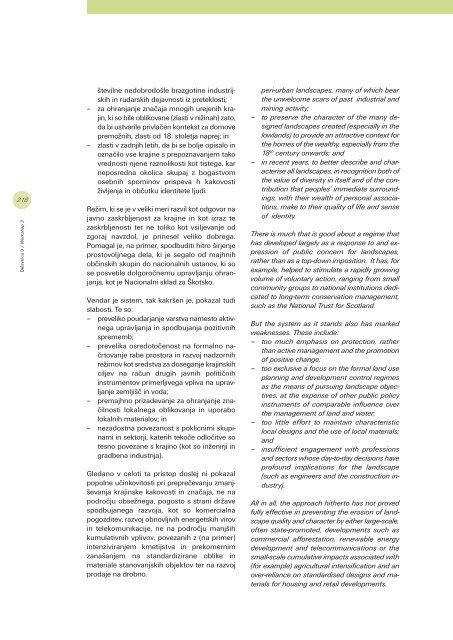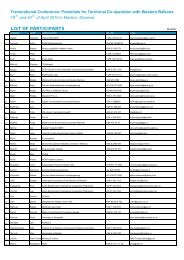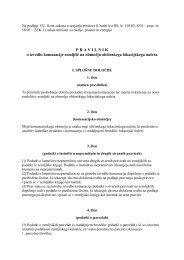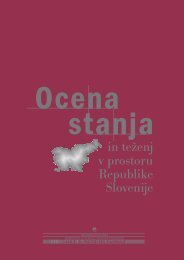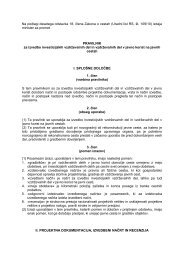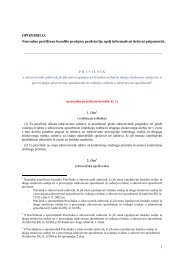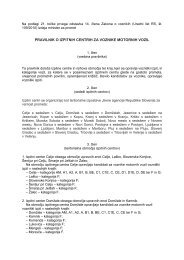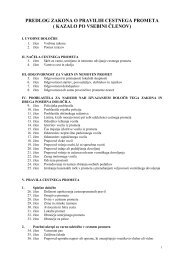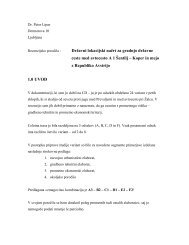evropska konvencija o krajini - Ministrstvo za infrastrukturo in prostor
evropska konvencija o krajini - Ministrstvo za infrastrukturo in prostor
evropska konvencija o krajini - Ministrstvo za infrastrukturo in prostor
You also want an ePaper? Increase the reach of your titles
YUMPU automatically turns print PDFs into web optimized ePapers that Google loves.
218Delavnica 3 / Workshop 3številne nedobrodošle brazgot<strong>in</strong>e <strong>in</strong>dustrijskih<strong>in</strong> rudarskih dejavnosti iz preteklosti;– <strong>za</strong> ohranjanje značaja mnogih urejenih kraj<strong>in</strong>,ki so bile oblikovane (zlasti v niž<strong>in</strong>ah) <strong>za</strong>to,da bi ustvarile privlačen kontekst <strong>za</strong> domovepremožnih, zlasti od 18. stoletja naprej; <strong>in</strong>– zlasti v <strong>za</strong>dnjih letih, da bi se bolje opisalo <strong>in</strong>označilo vse kraj<strong>in</strong>e s prepoznavanjem takovrednosti njene raznolikosti kot tistega, karneposredna okolica skupaj z bogastvomosebnih spom<strong>in</strong>ov prispeva h kakovostiživljenja <strong>in</strong> občutku identitete ljudi.Režim, ki se je v veliki meri razvil kot odgovor najavno <strong>za</strong>skrbljenost <strong>za</strong> kraj<strong>in</strong>e <strong>in</strong> kot izraz te<strong>za</strong>skrbljenosti ter ne toliko kot vsiljevanje odzgoraj navzdol, je pr<strong>in</strong>esel veliko dobrega.Pomagal je, na primer, spodbuditi hitro širjenjeprostovoljnega dela, ki je segalo od majhnihobč<strong>in</strong>skih skup<strong>in</strong> do nacionalnih ustanov, ki sose posvetile dolgoročnemu upravljanju ohranjanja,kot je Nacionalni sklad <strong>za</strong> Škotsko.Vendar je sistem, tak kakršen je, poka<strong>za</strong>l tudislabosti. Te so:– preveliko poudarjanje varstva namesto aktivnegaupravljanja <strong>in</strong> spodbujanja pozitivnihsprememb;– prevelika osredotočenost na formalno načrtovanjerabe <strong>prostor</strong>a <strong>in</strong> razvoj nadzornihrežimov kot sredstva <strong>za</strong> doseganje kraj<strong>in</strong>skihciljev na račun drugih javnih političnih<strong>in</strong>strumentov primerljivega vpliva na upravljanjezemljišč <strong>in</strong> voda;– premajhno pri<strong>za</strong>devanje <strong>za</strong> ohranjanje značilnostilokalnega oblikovanja <strong>in</strong> uporabolokalnih materialov; <strong>in</strong>– ne<strong>za</strong>dostna pove<strong>za</strong>nost s poklicnimi skup<strong>in</strong>ami<strong>in</strong> sektorji, katerih tekoče odločitve sotesno pove<strong>za</strong>ne s kraj<strong>in</strong>o (kot so <strong>in</strong>ženirji <strong>in</strong>gradbena <strong>in</strong>dustrija).Gledano v celoti ta pristop doslej ni poka<strong>za</strong>lpopolne uč<strong>in</strong>kovitosti pri preprečevanju zmanjševanjakraj<strong>in</strong>ske kakovosti <strong>in</strong> značaja, ne napodročju obsežnega, pogosto s strani državespodbujanega razvoja, kot so komercialnapogozditev, razvoj obnovljivih energetskih virov<strong>in</strong> telekomunikacije, ne na področju manjšihkumulativnih vplivov, pove<strong>za</strong>nih z (na primer)<strong>in</strong>tenziviranjem kmetijstva <strong>in</strong> prekomernim<strong>za</strong>našanjem na standardizirane oblike <strong>in</strong>materiale stanovanjskih objektov ter na razvojprodaje na drobno.peri-urban landscapes, many of which bearthe unwelcome scars of past <strong>in</strong>dustrial andm<strong>in</strong><strong>in</strong>g activity;– to preserve the character of the many designedlandscapes created (especially <strong>in</strong> thelowlands) to provide an attractive context forthe homes of the wealthy, especially from the18 th century onwards; and– <strong>in</strong> recent years, to better describe and characteriseall landscapes, <strong>in</strong> recognition both ofthe value of diversity <strong>in</strong> itself and of the contributionthat peoples’ immediate surround<strong>in</strong>gs,with their wealth of personal associations,make to their quality of life and senseof identity.There is much that is good about a regime thathas developed largely as a response to and expressionof public concern for landscapes,rather than as a top-down imposition. It has, forexample, helped to stimulate a rapidly grow<strong>in</strong>gvolume of voluntary action, rang<strong>in</strong>g from smallcommunity groups to national <strong>in</strong>stitutions dedicatedto long-term conservation management,such as the National Trust for Scotland.But the system as it stands also has markedweaknesses. These <strong>in</strong>clude:– too much emphasis on protection, ratherthan active management and the promotionof positive change;– too exclusive a focus on the formal land useplann<strong>in</strong>g and development control regimesas the means of pursu<strong>in</strong>g landscape objectives,at the expense of other public policy<strong>in</strong>struments of comparable <strong>in</strong>fluence overthe management of land and water;– too little effort to ma<strong>in</strong>ta<strong>in</strong> characteristiclocal designs and the use of local materials;and– <strong>in</strong>sufficient engagement with professionsand sectors whose day-to-day decisions haveprofound implications for the landscape(such as eng<strong>in</strong>eers and the construction <strong>in</strong>dustry).All <strong>in</strong> all, the approach hitherto has not provedfully effective <strong>in</strong> prevent<strong>in</strong>g the erosion of landscapequality and character by either large-scale,often state-promoted, developments such ascommercial afforestation, renewable energydevelopment and telecommunications or thesmall-scale cumulative impacts associated with(for example) agricultural <strong>in</strong>tensification and anover-reliance on standardised designs and materialsfor hous<strong>in</strong>g and retail developments.


